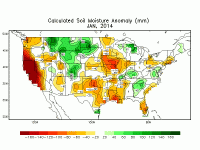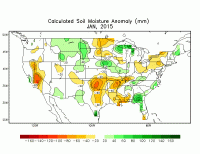Chip Redmond
EF4
It will be interesting to see how a lack of a deep snow pack across much of the northern plains affects things. Unless things change, I'd "guess" there will be a fairly quick warm up in the middle of the Country once the pattern does change. Will it mean severe weather? Who knows, just one of many things to consider.
Definitely a consideration and the resulting drought growth from the dry fall/winter may be a factor. My thinking is these regions will warm more than others further south that have had precipitation. This could assist in the warm sector dominating spring setups, speeding up the overall spring season resulting in less southern Plains storms. There has been some precipitation across the south this past year improving soil moisture from last year at this time. Compare soil moisture from 1/2014 to 1/2015 in attached images. Increased soil moisture across the southern Plains may help in the northward transport of Gulf moisture. It is important to note too that drought (and soil moisture) are actually about the same for the upper MS River basin, albeit, shifted slightly further north this year. So in reality, there may not be a trend towards much different of a season than 2014.
With a climatology trend towards neutrality in the ENSO going into spring/summer there is no clear signal (and probably won't be) any true guidance into spring. We really need to get a -PDO to get me excited so we can get more troughing in the west. Also, without a big swing in moisture to the west, I don't believe we will see an active southern US without help from a tropical/monsoonal like pattern. Problem with those is that they usually are split flow, and as already mentioned, isn't ideal for large events. Plus they typically occur late in the season and low levels just can't support decent storms. Therefore, I am leaning towards a short spring season to the south and a more active season across the north-central and northern Plains. Wouldn't complain if I am wrong though, have yet to see a tornado in Kansas since I moved here in 2013.
Chip





